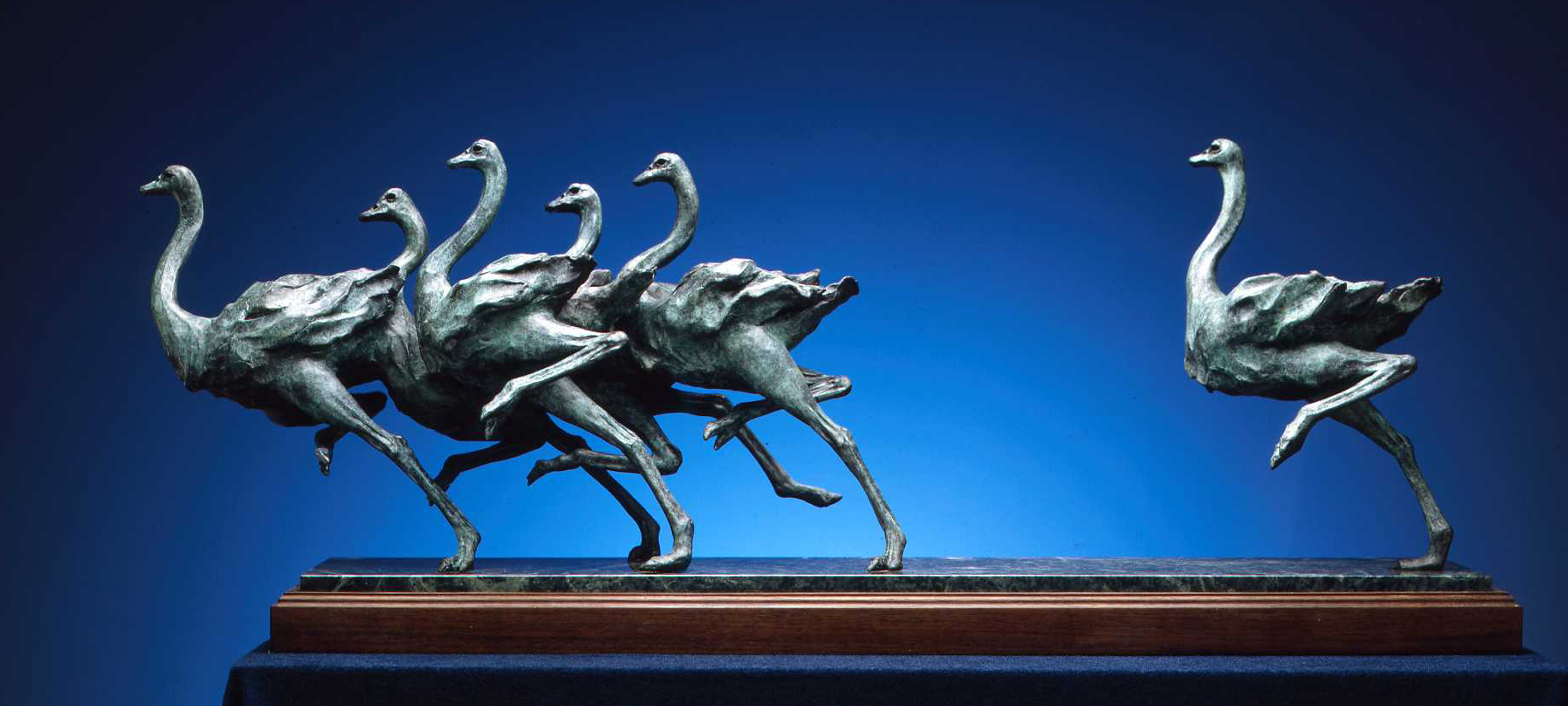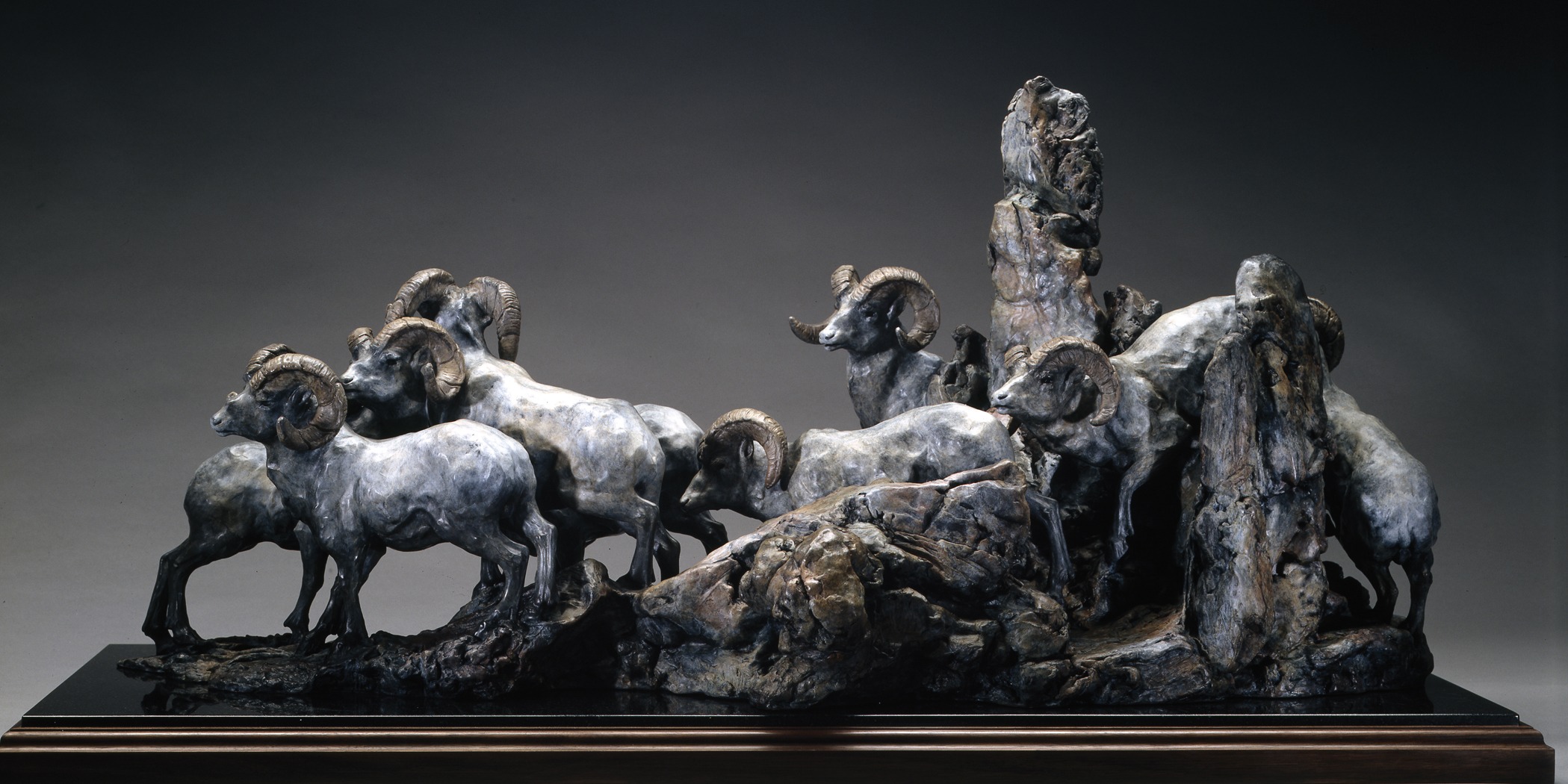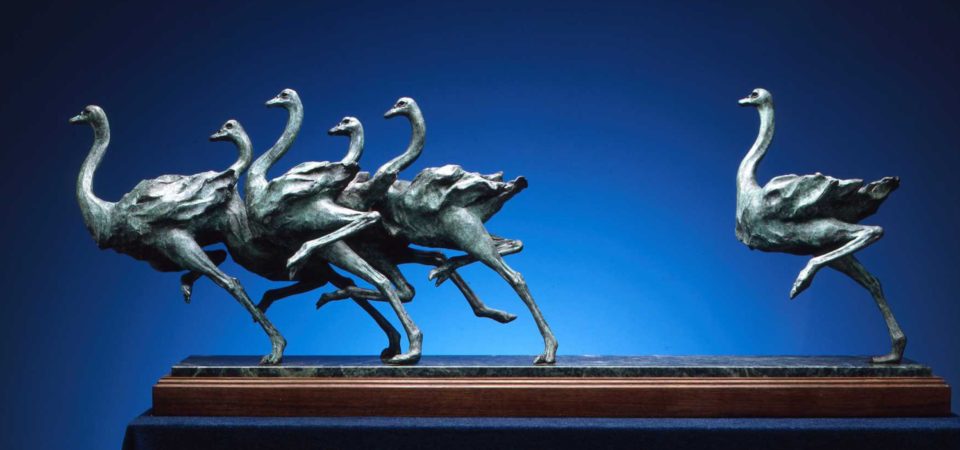Upon the stones
ten thousand years sooner than I,
Historians were scripting annals
Of birds that run.
Shared is the desire to record
this wizardry of nature,
this ancient family of the savanna.
And, in the telling, images of
beaks agape hawking their journey
Sailing a sea of sand and wind.
Scratched in stone,
forms in bronze
Unabridged by space or subsequence,
The need remains,
we recombine.
Children of ours,
show others their way.
–Sherry Salari Sander
My work represents a lifelong love affair with animals and art. My extensive travels and field research ranging from the Alaskan Bush to the African plains has fostered a deep and abiding appreciation for declining wildlife populations and the desire to preserve their habitat. By drawing attention to the beauty of animals and nature, I strive to endear the viewer to the subject and evoke a sense of responsibility for its preservation. I want the viewer to love and appreciate the delicate and precarious relationships animals have with their swiftly changing landscape and environment.

Sherry Salari Sander Herd of Birds, 1993, Bronze sculpture of ostrich 14x38x8 inches, Displayed in permanent collection of the Leigh Yawkey Woodson Art Museum. © Sherry Salari Sander
The tallest and heaviest bird on earth, the ostrich, has survived for more than one hundred and twenty million years due to its ability to adapt well to changes in its environment. It is a most fortunate species in this environmentally challenged world! This large, awkward bird is extremely graceful at full speed, able to run as fast as 43 miles per hour to escape danger. This sculpture is in the permanent collection of the Leigh Yawkey Woodson Art Museum.
By incorporating habitat, I strive to challenge my compositions to respectfully capture an animal’s interplay with nature, its gestures and personalities within an artful framework of balance, continuity and contrast. My hope is to lead viewers toward supporting those things, ideas and initiatives that can make a positive difference for affected wildlife populations worldwide. The power of “one” can be far reaching.

An example of my work featuring the interplay of animals with their particular environment is Through the Pass. History has been hard on bighorn populations. They were plagued by hunting, habitat alteration (ranchers moving into the mountain valleys) and disease (carried by introduction of domestic sheep). Their population declined, to near extinction in some areas, until the middle of the 20th century. Careful policy and management practices since then have bighorn populations recovering nicely. Climate change will challenge bighorn sheep in the decades ahead.
There are many things we, as individuals, can do to protect and improve our own property and community collectively affecting environmental change worldwide. My husband, Loren, and I live on a 300-acre ranch in northwest Montana lying smack dab on an old game trail that comes through our place from the river. It is home to fox, deer, coyote, wild turkeys, eagles, grizzly and black bear, wolves, ducks, hawks, heron, osprey, mountain lions, and others. This property sits atop a huge, shallow aquifer with massive movements of water. We feel a great responsibility to manage this property for its inhabitants.
This Springcreek Ranch contains the headwaters of Spring Creek which flows into the Flathead River, on into Flathead Lake and eventually finding its way into the Columbia Basin. Cutthroat trout spawn in these headwaters underscoring the need to protect their shrinking environment. We work with the U.S. Department of Agriculture’s Natural Resources Conservation Reserve Service to improve wetland habitat. We do this by looking at ways to reclaim the streambeds and establishing new plantings along the springs to prevent contamination of the groundwater sources. We plant trees and shrubs and install nesting areas by letting the grasses come back to provide cover and feed. The reclamation and preservation of our property has become our life’s work.
 Sherry Salari Sander grew up in northern California spending her youth in the company of a menagerie of animals and pets including a horse of her own. These creatures and a burning creative bent would lead to a life-long career in animal sculpting. She currently lives on a 300-acre ranch/wildlife refuge in northwestern Montana. Art of the West magazine included her among The Important and Enduring Works of America’s Twelve Most Compelling Artists. Sherry was the first woman to achieve the Society of Animal Artists’ Master Signature Artist status; she is a Fellow at the National Sculpture Society. Her work is included in the permanent collections of numerous museums and Public Art venues throughout the United States.
Sherry Salari Sander grew up in northern California spending her youth in the company of a menagerie of animals and pets including a horse of her own. These creatures and a burning creative bent would lead to a life-long career in animal sculpting. She currently lives on a 300-acre ranch/wildlife refuge in northwestern Montana. Art of the West magazine included her among The Important and Enduring Works of America’s Twelve Most Compelling Artists. Sherry was the first woman to achieve the Society of Animal Artists’ Master Signature Artist status; she is a Fellow at the National Sculpture Society. Her work is included in the permanent collections of numerous museums and Public Art venues throughout the United States.
This post is part of the MAHB’s Arts Community space –an open space for MAHB members to share, discuss, and connect with artwork processes and products pushing for change. Please visit the MAHB Arts Community to share and reflect on how art can promote critical changes in behavior and systems and contact Erika with any questions or suggestions you have regarding the new space.
MAHB Blog: https://mahb.stanford.edu/creative-expressions/herd-birds/
The views and opinions expressed through the MAHB Website are those of the contributing authors and do not necessarily reflect an official position of the MAHB. The MAHB aims to share a range of perspectives and welcomes the discussions that they prompt.

